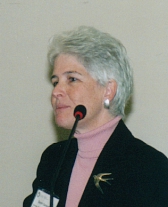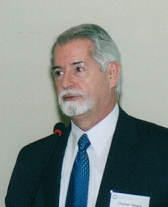CONGRESS ON ASSESSING AND MITIGATING ENVIRONMENTAL IMPACTS OF EMERGING CONTAMINANTS
Washington, D.C.
Sponsored by
U.S. GEOLOGICAL SURVEY
with support from
U.S. FOOD AND DRUG ADMINISTRATION
Recent studies by the U.S. Geological Survey have revealed the presence of pesticides, pharmaceuticals and other chemicals in a significant number of sampled streams and rivers. These contaminants, along with other emerging threats, are suspected of having measurable impacts on human and wildlife health—in some places male fish are producing eggs, amphibians are experiencing high levels of birth defects, and fish advisories are being issued.
RNRF's 2005 Congress identified problems and unintended consequences of emerging contaminants. Specific issues examined included: 1) efficacy of the existing regulatory framework; 2) research and monitoring needs; 3) impacts on human and wildlife health, and impacts on ecosystems; and 4) public information and education needs. Contaminant types examined included: pesticides and metabolites/degredates (featuring synthetic pyrethroids), pharmaceuticals, nanoparticles, and industrial chemicals (featuring brominated flame retardants).
SPEAKERS

Albert Grant
RNRF Chairman

Sarah Gerould
U.S. Geological Survey

Joel Coats
Iowa State University

Christian Daughton
U.S. EPA

Carl Orazio
U.S. Geological Survey

Clayton Teague
National Nanotechnology
Coordination Office

Mary O'Brien
University of Oregon
PROGRAM
DECEMBER 1, 2005
8:30 am - 9:00 am
Registration and Continental Breakfast
9:00 am - 9:05 am
Welcome and Opening Remarks
Albert A. Grant, RNRF Chairman, Potomac, Md.
9:05 am - 9:15 am
Congress Context and Goals
Robert D. Day, RNRF Executive Director, Bethesda, Md.
9:15 am - 9:50 am
Introduction to Emerging Contaminants and Unintended Consequences
Sarah Gerould, Congress Chair and Bureau Program Coordinator, Contaminant Biology Program, U.S. Geological Survey, Reston, Va.
The speaker will define emerging contaminants including the wide variety of potential sources ranging from manufacturing to bio-terrorism, and the variability of contaminant types including microorganisms, nanoparticles, and chemical compounds. The presentation will include a brief introduction to the broad range of regulatory approaches and the myriad impacts that such contaminants can have on wildlife, human health, and ecosystem function. A brief characterization of the extent of contamination (including geography and quantity) will be included.The speaker also will introduce the case studies including why particular compounds were chosen and what is hoped to be accomplished through examination of these compounds.
[PDF Presentation]
9:50 am - 10:15 am
Discussion and Questions
10:15 am - 10:45 am
Case Study I: Pesticides and Metabolites/Degredates--Synthetic Pyrethroids
Joel Coats, Professor of Insecticide Toxicology, Iowa State University, Ames, Iowa
Pesticides and their metabolites or degradates have been detected in surface and groundwater across the country. Agricultural runoff and nonpoint source pollution from residential and commercial applications have contributed to their widespread dispersion. Concerns have been raised about the impact that these substances, their metabolites or degradates (many of which can be more toxic than the parent compound) and mixtures have on wildlife and humans. Use of synthetic pyrethroids has increased, particularly in control of vectors of emerging diseases (such as mosquitoes for West Nile virus). Pyrethroids are known to be extremely toxic in aquatic ecosystems. However, little information is known about additional wildlife or human health impacts. The speaker will focus on known and suspected impacts on the environment, and human and wildlife health, including the unintended or unanticipated consequences. Existing regulatory mechanisms and opportunities for overcoming perceived ineffectiveness, along with research, monitoring, and public education needs will be examined.
[PDF Presentation]
10:45 am - 11:15 am
Discussion and Questions
11:15 am - 11:35 am
Break
11:35 am - 12:05 pm
Case Study II: Pharmaceuticals
Christian Daughton, Chief, Environmental Chemistry Branch, National Exposure Research Laboratory, Environmental Protection Agency, Las Vegas, Nev.
Pharmaceuticals and personal care products range from prescription drugs to over-the-counter medicines and caffeine. These contaminants can enter the environment through the disposal of expired prescriptions (by flushing into the wastewater stream or leaching from landfills) or excretion due to partial metabolization. Antibiotic and hormone use in Concentrated Animal Feedlot Operations (CAFOs) have raised concerns about pharmaceutical introductions into local water bodies. These products are suspected of contributing to rising incidences of cancer and genetic defects in fish and amphibian populations. Other wildlife and humans also may be at risk. The speaker will direct attention to some of these risks and other suspected environmental, human and wildlife health impacts. Regulatory deficiencies, and research, monitoring, and public education needs also will be discussed.
[PDF Presentation]
12:05 pm - 12:35 pm
Discussion and Questions
12:45 pm - 1:45 pm
Lunch
1:45 pm - 2:15 pm
Case Study III: Industrial Chemicals--Brominated Flame Retardants
Carl Orazio, Chief, Environmental Chemistry Branch, Columbia Environmental Research Center, U.S. Geological Survey, Columbia, Mo.
Numerous chemicals designed to meet perceived societal and manufacturing needs are developed and produced annually. However, many of these chemicals are introduced with little thought (or understanding) of how they will impact humans, ecosystems, or wildlife. Recent contaminants of concern include MTBE, PFOSs, and PBDEs. Brominated flame retardants (PBDEs) appear in many everyday products ranging from computers to carpeting and upholstery. With their widespread use, concerns related to disposal and off gassing have surfaced. They are suspected of being bioaccumulative, persistent, and widely dispersed throughout the environment, and pose a risk to the environment and human and wildlife health. Europe and California have taken steps to regulate these substances, but further U.S. action has stalled. Current efforts to regulate such chemicals and opportunities to overcome existing regulatory shortcomings will be discussed. Known and suspected human and wildlife health impacts, along with other environmental effects will be examined. Needs within the scientific and educational communities for better understanding and mitigation of such effects also will be presented.
[PDF Presentation]
2:15 pm - 2:45 pm
Discussion and Questions
2:45 pm - 3:15 pm
Case Study IV: Nanoparticles
Clayton Teague, Director, Federal National Nanotechnology Coordination Office, Washington, D.C.
Nanotechnology has been touted as the next industrial revolution. Manufacturers and researchers are developing and utilizing nanoparticles at a fast pace. However, there is little knowledge or examination of potential consequences to human health and the environment. Early research has shown that the comparatively large surface area can increase toxicity. Inhaled particles are believed to penetrate deep into the lungs where they can move into other parts of the body including the liver and brain. There are concerns about the extent to which existing regulatory mechanisms can address human and wildlife health and environmental concerns. The speaker will examine how nanoscale materials and products are being covered under existing regulatory structures, and how the regulatory agencies are evaluating and will continue to evaluate the efficacy of those structures.
3:15 pm - 3:45 pm
Discussion and Questions
3:45 pm - 4:30 pm
Delegate Round Table Discussion: Regional Experiences
Informal discussion of delegate experiences in monitoring and mitigating the effects of contaminants
4:30 pm - 6:00 pm
Reception
DECEMBER 2, 2005
8:30 am - 9:00 am
Continental Breakfast
9:00 am - 9:35 am
How Can We Improve Our Environmental Relationship with New Chemicals?
Mary O'Brien, author, Making Better Environmental Decisions: An Alternative to Risk Assessment, Eugene, Ore.
[PDF Presentation]
9:35 am - 10:00 am
Discussion and Questions
10:00 am - 10:10 am
Explanation of Working Group Procedures
Ryan M. Colker, RNRF Director of Programs, Bethesda, Md.
10:10 am - 10:30 am
Break
10:30 am - 11:40 am
Working Group Session I
11:40 am - 12:40 pm
Working Group Session II
12:40 pm - 1:40 pm
Lunch
1:40 pm - 2:40 pm
Working Group Session III
2:40 pm - 3:00 pm
Break
3:00 pm - 4:00 pm
Working Group Session IV
4:00 pm - 4:15 pm
Necessary Next Steps and Concluding Remarks
Robert D. Day, RNRF Executive Director, Bethesda, Md.
CONGRESS PROGRAM COMMITTEE
Chair:
Sarah Gerould, Bureau Program Coordinator, U.S. Geological Survey (Society of Environmental Toxicology and Chemistry)
Members:
Deen Boe, Washington Representative, Society for Range Management
Robert Day, RNRF Executive Director
Richard Engberg, Technical Specialist, American Water Resources Association
Peter Folger, Public Affairs Manager, American Geophysical Union
Albert Grant, Consulting Civil Engineer, RNRF Chairman
Cathy O'Riordan, Office of Public Affairs, American Geophysical Union
Brian Parsons, Executive Director, Environmental and Water Resources Institute, American Society of Civil Engineers
Howard Rosen, Resource Valuation and Use Research, USDA Forest Service (Society of Wood Science and Technology)
Rita Schoeny, Senior Science Advisor, Office of Water, U.S. Environmental Protection Agency
Steve Sheffield, Adjunct Professor of Wildlife Toxicology, Virginia Tech (The Wildlife Society)
Ellen Silbergeld, Professor, Environmental Health Sciences, Bloomberg School of Public Health, Johns Hopkins University
Barry Starke, Principal, Earth Design Associates, RNRF Vice Chairman (American Society of Landscape Architects)
David Trauger, Director, Northern Virginia Center, College of Natural Resources, Virginia Tech
Tamim Younos, Interim Director, Virginia Water Resources Research Center, Virginia Tech (Universities Council on Water Resources)
Staff Liaisons:
Ryan M. Colker, RNRF Program Director
